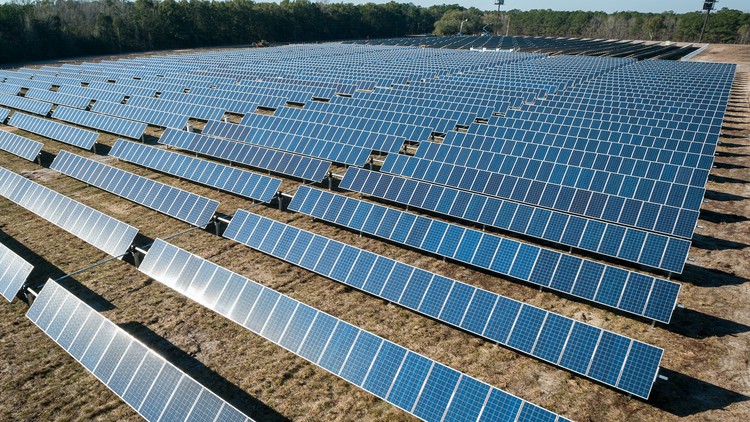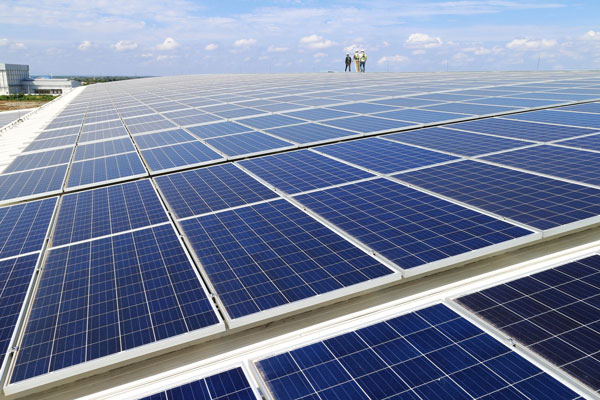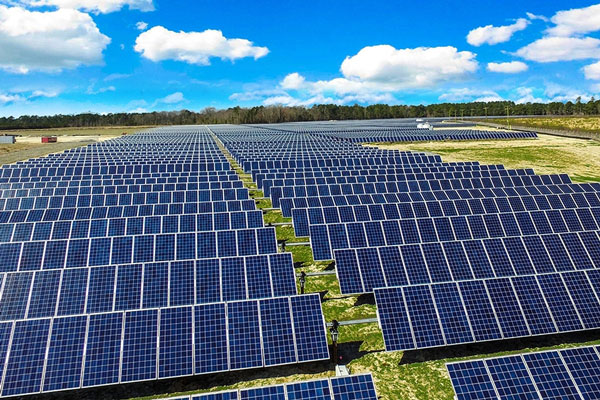Solar panel tracking systems boost energy output, maintain high efficiency all day, save space, enhance durability, and work well with existing setups.
Increased Energy Output
Increasing energy production of solar panels by up to 40%, solar tracking systems increase energy production by orienting the modules with the sun throughout daylight hours. Based on the sun's position in the sky, the modules are adjusted directly to it on all 4 sides with these systems that works well from sunup to sundown, ensuring that solar radiation is absorbed as naturally and efficiently as possible which translates into low costs.

Performance in Different Geographic Locations
In areas such as Arizona with lots of sun, a dual-axis tracking system can improve energy production up to 45% over fixed systems. This configuration lets the panels catch all the sunrays as it moves not just throughout the day and its path changes in different seasons too.
Impact on Output
Solar Trackers Were Peterson has shown that solar trackers can be their study was done in just the thing on a solar farm in Nevada. During peak sunlight hours, tracked panels output up to 30-35% more energy then fixed panels. These stats are especially meaningful in peak summer months, when all of our air conditioners kick into overdrive, too.
Tracking System Optimization Techniques
GPS and sensor based technology are used in solar trackers to find the best possible angles for solar panels. The panels point with the rotating angle varying with time from azimuth and elevation, to make sure that they always face the sun for the highest exposure. For example, a complex solar-tracking installation in California employs a lookahead predictive algorithm that not only reacts to the current position of the sun but also forecasts where the sun is going, tilting panels ahead of time to prevent energy waste.
Tangible Benefits Realised
In numbers, tracking systems can increase energy production by as much as 25% annually. This is because the panels are oriented to allow them to generate maximum energy at all times of the day. Maximizing solar exposure is a leading practice in high-potential solar locations and it transforms investments in solar installations into superior energy alternatives.
High Efficiency Throughout The Day
Solar panel tracking systems operate all day and track the path of the sun to catch as much sunlight as possible and have maximum power generation throughout the daylight.Morning & Evening Productiveness
Fixed solar panels pointing due south will produce most of their power around midday, when the sun is high and directly overhead. But the high productivity hours are extended by tracking systems that follow the sun from when it rises early in the morning, throughout the day, and sets late into the evening. For instance, a solar project in Oregon found that with tracking technology, the panels were already producing significant power by 7 AM - two hours earlier than a similarly oriented fixed system would begin generating substantial output - and continued to generate until 7 PM, essentially increasing the number of productive hours available for four more hours over fixed installations.not affect the plants hydroponic
Seasons affect the path of sun and hence efficiency of solar panels. These systems adjust the angle and orientation of panels to track these movements, increasing the absorption of energy during shorter winter days and longer summer days. In a New York study, innovative solar tracking systems were shown to produce up to 25% more energy in winter and 20% more in summer than traditional fixed solar technology as they align better with the sun's lazy winter tracks and higher summer tracks.Real-Time Sun Tracking
The latest solar trackers fiddle with the panels around in real-time style, using predictive algorithms. By allowing the panels to follow the sun across the sky, this process guarantees that they are always oriented properly to perform at maximum capacity, reducing energy loss as a result of misalignment during parts of the day when fixed systems are off kilter. Real-time tracking kept a solar hub in Texas running at peak efficiency from dawn to dusk, enabling energy production to reach 30% above the rates of non-tracking systems over that span.Impact on Overall Performance
By continuously adjusting panels to directly face the sun the midday peak and drop-off in energy production associated with fixed systems is removed. This results in a more stable and uniform release of energy, which is important for large solar farms as they must accurately predict and regulate power output. For tracking verses fixed system data from California, the power generation of tracking systems was greater than fixed systems by 90% in the early afternoon and late morning and over 75% in the beginning of the day.Reduce Space Requirements
Solar panel tracking systems maximize the use of land by increasing the output of energy per unit area, which is especially useful in places where land is scarce and expensive.
Efficiency in Land Use
By enabling fewer panels to create the same amount of power as more numerous fixed panels, solar trackers increase the amount of energy generated per square meter of land. One example was a project in urban San Francisco that applied tracking technology to the rooftop of a tiny home because it could maximize how much energy the system would yield with so little area to work with. The project claimed that by using the space efficiently, it saved around 20% of the space versus a fixed system, while still being able to generate the same amount of power...
Orienting Superimposed Enclosures in Limited Spaces
Using dual-axis tracking systems, solar farm in Japan were able to increase energy production by 40% compared to traditional fixed systems due to the limited space. Such improvements in energy production effectiveness translate directly to a reduced amount of land is necessary for the solar farm to produce an equivalent quantity of energy, and decreasing the per-kilowatt-hour cost of land.
Innovations In Design For Small Spaces
Typically the tracking design is more compact and integrated, which is better suited for residential or even commercial buildings where roof space is limited. One breakthrough in tracking technology is the development of vertical stacking, which piles the panels so one row of panels tracks the sun independently above another. It was used in a commercial building in Berlin where we doubled the energy capacity without increasing the area occupied.
Impact on Project Economics
Solar tracking systems can be installed closer together to take up less space and in many cases decrease the overall cost of a solar project. This decrease is not only in land use, but also in the costs of site preparation and infrastructure work. A cost comparison in New Mexico found that the land expense for a standard fixed system was 30% more than a tracked solar project with equal energy production, creating substantial overall project savings.
Long-Term Reliability And Durability
Solar tracking systems can be built to handle a broad range of environments making them not only more reliable over the long term, but also ensuring the investment made in solar technology is going to survive well into the future.Engineering for Weather-Pocalypses
Not only are solar trackers constructed of durable materials, they too are also designed to withstand the harshest weather such as storms, high winds, heavy snow and intense heat. In another application, an arid Colorado solar farm is deploying trackers designed with a wind-stow feature that angles the panels horizontally to ride out passing storms. Proven to decrease storm damage from 0-60% over fixed installations.Maintenance and quality of the components
Solar tracking systems are, likewise, of a long-term durability due to the use of proper components and regular maintenance cycles. There is a solar tracking system in operation for 15 years in California, and it has suffered little degradation over time (98% + of its initial efficiency). The system is built on proprietary bearings and motors designed for 24/7 operation in an outdoor environment.Technological Advancement
Today, tracking systems are also getting better and now incorporate newer tech such as predictive maintenance or real-time monitoring to anticipate and deal with issues before they cause costly downtime. One example of this is a machine learning deployment used in the operation of a solar asset in Nevada, which is analyzing performance data to predict component defects on a large-scale solar installation. Taking a preventative approach has increased the lifetime of their tracking systems by 25%, meaning fewer repairs less repair cost.Sustained Performance Over Time Study
Another study in Spain measured the relative long-term performance of solar powered tracking and fixed solar panels over a decade, and found correct on-axis dual axis tracked installations fared far better than the fixed tilt installations. The sensed system degraded at about 0.5% average each year, while the fixed one was losing around 1.2% output every year. What this demonstrates is the superior longevity and upkeep mechanisms demonstrated in tracking technologies.
Compatibility With Existing Systems
Since these solar panel tracking systems are designed to fit seamlessly with current solar installations, and that they do all the heavy lifting for those panels to be a heck of a lot more productive, no other huge modifications need to happen as well.
Compatibility with Traditional Solar Arrays
Solar trackers offer a way to increase the energy output of older solar installations, enabling more revenue for participants. For example, a solar farm in Ontario was able to retrofit tracking into a ten-year-old static installation, which increased the power output by around 20%. The retrofit required few modifications to the existing infrastructure, as it reused the original mounting points and electrical connections.
Flexible System Design
The modern tracking systems are plug and play and will adapt to all types of solar panels in terms of capacities. This flexibility can be seen in a German project where multiple types and sizes of solar panels were installed, using a fresh tracking system. It featured a layout that was able to manage components from three separate manufacturers, demonstrating the flexibility of the system in responding to varying configurations.
Technology Compatibility
Many tracking systems have integrated, modern control systems that work with your current inverters and monitoring solutions. Most importantly, it is the interoperability that came in handy during a recent installation in Texas where the new trackers had to communicate with an aging inverter on site; all that was needed was alterations to parameters being traced without any hardware replacement making its work straightforward. The controller for the tracking system was able to easily interface with the inverter for real-time adjustments and data all without interrupting the daily operations of the inverter.
Upgrading Impact
For solar modules performing poorly due to improper orientation, it is usually cheaper to add a tracking system rather than replacing the panels altogether. There's the case of a California home-owner who chose a single-axis tracker installation rather than replacing several older panels in another residential location. This led to a 15% increase in power supply which was much more cost effective than replacing the whole panels.



